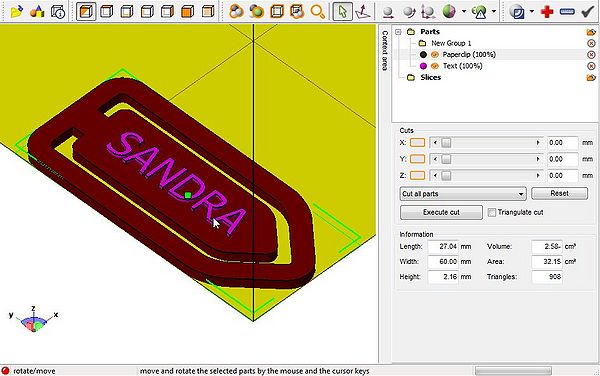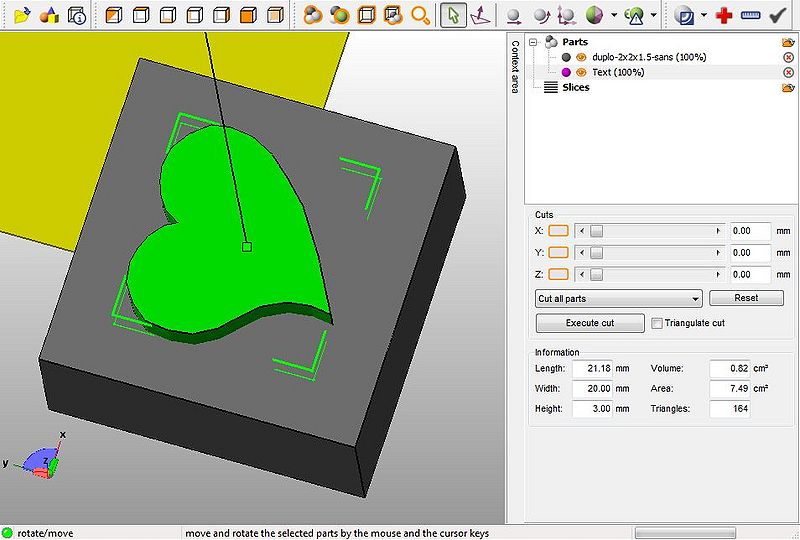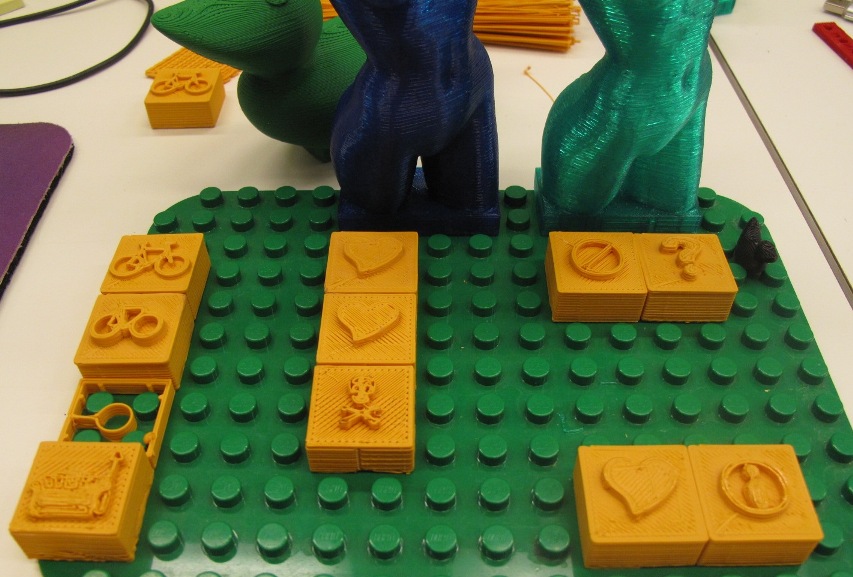Netfabb Studio tutorial
Introduction
“netfabb Studio is a software tailored for additive fabrication, rapid prototyping and 3D printing. It includes the ability of viewing, editing, repairing and analyzing stl-files or slice-based files in various formats.”. The version called Netfabb Studio Basic (as of fall 2010) is free and it runs under Windows / Linux and MC. For Linux, you should have OpenGL support.
Netfabb Studio is a must have tool for printing with the RapMan.
Other versions:
- netfabb Cloud Services, extends the functionality of the free netfabb Studio Basic.
- Netfabb Studio Professional is a recommended pro version. On important feature is merging STL files which makes life a lot easier if your printable object is made from several others (e.g. a duck sitting on a Lego brick).
- Netfabb engine for RapMan is a commercial inexpensive g-code generator for rapman that you could use instead of skeinforge. This product works as an addon of Netfabb Studio.
See also:
- Meshlab for RapMan tutorial (for layer merging)
- Skeinforge for RapMan for printing with a RapMan
Base functionalities
Views
In any 3D drawing programs you can change your view of an object. This can be achieved mainly through mouse gestures
- Rotation of the view (not of the object): Right-Mouse-down
- Zooming in: Mouse wheel or ctrl-right-mouse-down
- Panning: Middle mouse down.
In addition, you can set predefined Views of the scene either through icons on the tool bar or the View Menu. This is a very useful feature, if you want to quickly check whether the x-y-z positions are ok.
In order to "see" where the print will go in x-y-z space, I also suggest turning on the "platform view" with Menu: View->Show Platform. This does not represent the print platform, the x=0,y=0 corner of the by default "yellow" platform is on the lower left. In a RapMan printer the x=0, y=0 is in the middle of the print bed. In other words, we suggest putting your object near the lower left corner, or put more simple. The center of your object should be fairly close to x=0,y=0. Obviously the bottom (and not the center) of your object must be z=0.
Positioning, rotation and resizing
Parts are manipulated either through icons on the tool bar, the Parts menu or shortcuts
- Positioning and scaling
Positioning is really easy because one can quickly choose a view from one of seven views (e.g. top, bottom, left, right, front, back) and then either move the object or drag a corner of the (green) bounding box rectangle.
For precision work, e.g. align to z=0 one can use pop-ups in the Part menu or some shortcuts:
- Move: Ctrl-V
- Rotate: Ctrl-D
- Scale: CTRL-S
Simple Mashup example - duplos for grown ups
See also: OpenScad beginners tutorial
- Get a ready made duplo without caps
- Get a parametric DUPLO for Thingyverse: parametric lego duplo by danielkschneider
- A good piece is the duplo-2x2x1.5-sans.stl
- Open in Netfabb
- Project -> New
- Project -> Open the .STL file
- Create 3D text
- Click on the "Create Primitives Icon" (second to the left)
- Set Height to 20.mm and depth to 2.0 or 3.0 mm
- Double click on Text and enter a letter, e.g. "Y" (read the next item about "webdings")
- Change the Font to Webdings (double click), select bold and select size = 72
- Click on Apply.
- Align
Use each of the seven views to align and make sure that the symbol will be on top.
- Selecting webdings
- Read Webdings and wingdings
- Basically, under Windows open the character table, then copy and paste.
- Merge the two
- Since you can't do this in the free version, you will have to export both parts
- Menu->Part->Export Part; Select .STL (ascii)
- Now save the whole thing as Netfabb project (Project->Save), in case you did something wrong.
- Then import both exported parts to Meshlab and merge layers. Meshlab is a really difficult program, but merging two layers is very easy. See the Meshlab for RapMan tutorial
- Call the file something like duplo-symbol.stl
- Clean up the .STL
- Import the combined duplo-symbol.stl to netfabb
- Then clean it up by pressing the "+" button.
- Click on "automatic repair"
- click on Apply repair
- Now export again as part: Menu->Part->Export Part. You can overwrite the duplo-symbol-stl since its broken anyhow.
- Printing
- Now you can import the fixed .STL file to skeinforge
- Recommended settings for our Rapman v3.1 (have to check this a bit more):
- Carve - Layer thickness = 0.4 (0.45 is sort of ok) - Speed - Feed rate (head spead) = 16 Flow rate setting (RPM/10) = 450 to 500 (this is a lot, but it's for the top) Perimeter feed and flow rates = 0.9 to 1.0 (0.9 will make it more precise) - Temperature - Base, Interface, support = 238 All others = 247 - Fill - Solid surface thickness = 0.4 - Raft - Base Layer thickness = 2.5 Base Feed Rate Multiplier = 0.90 Interface Layers = 2 Nozzle lifts (all three) = 0.35
- In addition I tried using cool (for orbiting) but I did removed all the temperature changes in the g-code (else the print head will got to waiting each time)
The ones that have ugly walls were printed with a too high layer thickness and too little flow rate ....
Warning: This setting squeezes down layers, so stay next to your printer. It may get stuck on something that would stick out.
Cleaning
Cleaning of .STL files is an absolute must and this software usually does a great job. Click on the red plus sign, then commit.
Export to STL
In the free version, you only can export single object (part) as .STL. Use the free (but more difficult) Meshlabs to merge several objects or buy the Netfabb Pro version :)
If you are a programmer, using OpenScad to position and to merge .STL objects (or other formats) is an option you should consider.
Links
- Download



